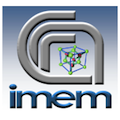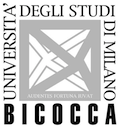Scientific
background
Conventional flash memories are limited by short lifetimes, low speeds and endurances (set/reset cycles); moreover, the scalability
limit of the flash technology is going to be reached in a few years. Such limitations can be overcome by Phase Change Memories (PCMs),
based on chalcogenide materials, in which the programming function depends on the different electrical resistance offered by their
amorphous and crystalline phases, that can be reversibly induced by suitable current pulses. Among the chalcogenides, Ge2Sb2Te5
(GST) shows high crystallization rates and is very stable at the operating temperatures. In addition, its electrical resistance
varies by several orders of magnitude (GST is almost insulating when amorphous) and the phase transition is completely reversible,
with a high cycling endurance [1]. In a typical PCM, write/read current pulses are induced by a heater and metallic contacts can read
the resistivity (at low bias). Most of the GST thin films for PCM applications are nowadays obtained by physical deposition, such as
RF sputtering [2], with some uniform coverage problems (low conformality) on the whole sidewalls of the trenches. New possibilities in
terms of conformality and process control are offered by chemical deposition techniques, among which the Metal Organic Chemical Vapor
Deposition (MOCVD) is featured by high compositional control of the thin films, high purity, industrial scalability on 12'' substrates
and relatively high deposition rates [3]. Important issues for development and commercialization of PCM in the near future are the
increase of the storage capacity per cell and the reduction of the power consumption and costs. This can be achieved by further
pushing down to the nano-scale the size of the GST-based memory cells, since lowering active material volumes to be programmed
requires shorter and less intense current pulse and at the same time provides higher cell density. Some works reporting on the
realization and properties of nano-GST particles by laser ablation, demonstrate that the size reduction can lower the reset current
by 3 orders of magnitude with respect to that of conventional GST films-based cells [4]. Only a few studies deal with the fabrication
of nanosized elements for PCM cells [5,6]. A very attractive option involves the use of chalcogenide nanowires (NWs) for highly scaled
PCM devices and multi-level memory applications. To this aim, single crystal NWs [7] and core-shell NWs [8] have been deposited, for
instance, by vapor transport method. Notably, no report in the literature is present about the MOCVD deposition of GST NWs.
References
[1] A. L. Lacaita, Solid-State Electronics, 50 (2006) 24-31
[2] Y.F. Cai, P. Zhou, Y.Y. Lin, T.A. Tang, L.Y. Chen, J. Li, B.W. Qiao, Y.F. Lai, J. Feng, B.-C. Cai, B. Chen, Chin. Phys. Lett., 24 (3) (2007) 781.
[3] J.I. Lee, H. Park, S.L. Cho, Y.L. Park, B.J. Bae, J.H. Park, J.S. Park, H.G. An, J.S. Bae, D.H. Ahn, Y.T. Kim, H. Horii, S. A. Song , J.C. Shin, S.O. Park, H.S. Kim, U-In. Chung, J.T. Moon, B.I. Ryu, 2007 Symposium on VLSI Technology Digest of Technical Papers, p. 102.
[4] D-S- Suh, E. Lee, K. H. P. Kim, J.-S. Noh, W-C. Shin, Y.-S. Kang, Y Khang, H.R. Yoon, W. J, Appl. Phys. Lett., 90 (2007) 023101
[5] H. Lee, S.H. Hong, K.Y. Yang, G.Y. Jung, Microelectronic Engineering 84 (2007) 573-576
[6] Hangbing Lv, Yinyin Lin, Peng Zhou, Tingao Tang, Baowei Qiao, Yunfeng Lai, Jie Feng and Bomy Chen, Semicond. Sci. Technol., 21 (2006) 1013-1017
[7] S.-H. Lee, Y. Jung, R. Agarwal, Nature Nanotechnology, 2 (2007) 626.
[8] Y. Jung, S.-H. Lee, A.T. Jennings, R. Agarwal, Nano Lett., 8 (2008) 2056




